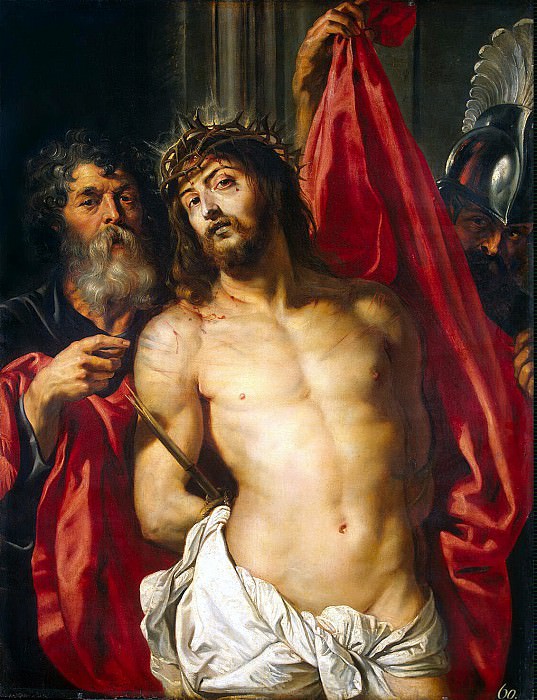Christ Crowned with Thorns Peter Paul Rubens (1577-1640)
Peter Paul Rubens – Christ Crowned with Thorns
Edit attribution
Image taken from other album: gallerix.org/s/797322277/N/114859008/
Download full size: 1131×1476 px (0,7 Mb)
Painter: Peter Paul Rubens
This painting belongs to the early work of Peter Paul Rubens, but here we can already see that the master has a good knowledge of human anatomy. Creating in the Baroque period, the artist studied a lot the works of ancient masters and their sculptural heritage. Therefore, in this work we see the careful drawing of all the muscles of the human body. The subject depicted in the painting illustrates the lines written in the Gospel of Matthew.
Description of Peter Rubens’ painting Christ in the Crown of Thorns
This painting belongs to the early work of Peter Paul Rubens, but here we can already see that the master has a good knowledge of human anatomy. Creating in the Baroque period, the artist studied a lot the works of ancient masters and their sculptural heritage. Therefore, in this work we see the careful drawing of all the muscles of the human body.
The subject depicted in the painting illustrates the lines written in the Gospel of Matthew. It is believed that when Jesus was captured, he was brought immediately to Pontius Pilate. The Roman procurator didn’t know whether to let Jesus go or condemn him. But in the face of the people’s pressure, he decided to sentence him to death. He absolved himself of this responsibility, "washed his hands of it".
The painting depicts the moment when Jesus is led out to be shown to the people. He is about to be executed for the ideas he preaches. But now they have decided to make a mockery of him. A crown of thorns is placed on his head as a symbol of a non-existent crown. He is mocked, the sharp crown with its thorns causes excruciating pain.
Behind Jesus walks Pontius Pilate himself. He points the finger of his right hand somewhere forward, as if to make way for Jesus. Behind the martyr we see a Roman legionary. He is wearing a military garment and carrying a large red cloth in his hands. The soldier tries to put the cloth over Jesus’ shoulders to make him look more like an imaginary monarch. The color of the cloth is not accidental here either. Red is not only the color of the blood that is about to be shed by Jesus. Red has also always been considered a symbol of a strong, powerful monarchy. But in this work, the red cloak is only a mockery and mockery.
After Jesus was dressed up in royal attire, the whole Roman people began to mock him. Stones and sticks were thrown at the martyr. But Jesus is not portrayed as frightened or miserable. He calmly walks towards the dangers, he does not try to escape.
Кому понравилось
Пожалуйста, подождите
На эту операцию может потребоваться несколько секунд.
Информация появится в новом окне,
если открытие новых окон не запрещено в настройках вашего браузера.
You need to login
Для работы с коллекциями – пожалуйста, войдите в аккаунт (open in new window).









![Peter Paul Rubens - Raising of the Cross [Detail]](http://cdn.gallerix.asia/j/_EX/754398988/986788940.webp)

![Peter Paul Rubens - Equestrian portrait of King Philip IV of Spain [circle]](http://cdn.gallerix.asia/j/_EX/754398988/2948910682.webp)








You cannot comment Why?
To the left, a bearded man observes the scene; he holds what appears to be a cloth or rag, perhaps intended for wiping away blood or tears. His expression is one of detached scrutiny, bordering on amusement. On the right, another figure looms, partially obscured by a vibrant red drape. This individual’s face is not fully visible but seems to hold an air of authority and control over the proceedings. The deep crimson fabric serves as a stark contrast to the pale flesh tones of the central figure, intensifying the visual drama.
The lighting in this painting is dramatic; it highlights the musculature of the mans torso while casting portions of the surrounding figures into shadow. This selective illumination directs the viewer’s gaze toward the suffering individual and emphasizes his vulnerability.
Subtleties within the work suggest a complex narrative beyond simple depiction of pain. The detached observation of the left-hand figure implies a societal or institutional endorsement of this act, hinting at power dynamics and complicity. The red drape, often associated with royalty or martyrdom, introduces an element of ambiguity – is this a scene of degradation or a prelude to something greater? The overall effect is one of profound psychological tension, prompting reflection on themes of suffering, authority, and the nature of sacrifice.